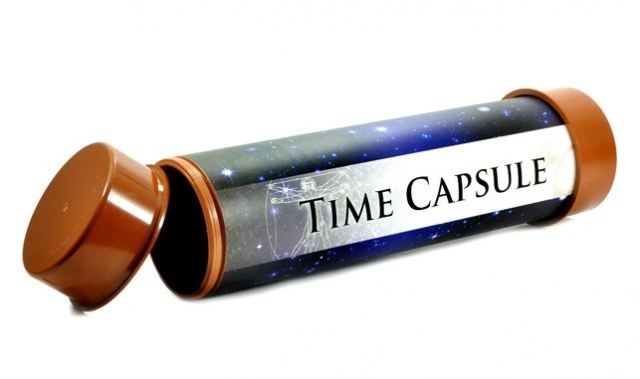A timely idea for Rossland?
Ryan McGill presented council with a vision he struck upon last summer and has since discussed with the principals of Rossland’s three schools, Jackie Drysdale of the Heritage Commission, and Katie Albright of the public library: to bury a community time capsule, perhaps in the library lawn during Golden City Days this year, and mark it with a boulder and a plaque—’to be unearthed in 2113.’
McGill, a resident of Rossland for 5 years along with his wife and two children, said the word ‘time capsule,’ fills the air with “magic, mystery, and wonder.” “It’s a daydream that touches us all. Who hasn’t imagined as a child, digging in the yard and finding something lost in time?”
“My kids found a small, little capsule in our yard in Rossland,” he said. “The idea kind of spread.” Looking around the Kootenays for community time capsules, he added, “I don’t see anything like it. I think there are some out there that are very industry-specific.”
Much of McGill’s work with the Canada Border Services Agency involves “preserving our own heritage,” for example with the Boundary Commission preserving “monuments, benchmarks, and obelisks.” But this is the first time he’s attempted to spearhead a time capsule project.
It would capture a “snapshot” he said of “what defines Rossland today.” He said it would be a city landmark to “celebrate in its design, cherish in its preservation, and anticipate in its discovery.”
The key to success, he said, will be community participation. “It’s the ultimate message in a bottle. It will say we are proud of our community.” In his design briefs to council, he said, “I’ve really held back with my opinions; I really want it to come from the community.”
The planning and design stage will be “involved,” he said, and will require community input “from creation of a task force, community involvement, site selection, procurement of all the physical things you would need, the science of preservation, determining a seal date and ceremony, and the length of time until discovery.”
There is an enormous variety of time capsules, McGill explained, from the Crypt of Civilization, the original 1940 time capsule, a room that will not be opened until 8113, to others suspended above the ground, as works of art, or in space.
“It’s limited to what we want to put in it, and the science of preservation really limits what you can put in it,” McGill said.
“The only one I would speak to is the length of time until discovery,” he said. “I would only encourage the longest time possible. One hundred years is very common.”
He pointed out that there are already two time capsules in Rossland, one at the old Bank of Montreal building—buried during construction in 1898—and the other at the bank vault of the Credit Union.
“Neither are what I would describe as community-relevant nor celebrated,” he said.
He explained, “They’re not publicly known, they’re not anticipated in discovery.” Mentioned in a newspaper article over one hundred years ago, the BMO capsule was not marked, although he and the building owner Fletcher Quince “have an idea where it might be.” He added that the BMO capsule did not have a date set for discovery, so it is “not anticipated,” like the unearthing of a prominently displayed capsule would be.
Furthermore, the BMO capsule is likely “industry-specific,” he said, with things like “stamps and architectural drawings, nothing put in by the community.” His understanding was that the capsule at the Credit Union was similarly industry-specific. “Essentially, it’s nothing the community has had any input in.”
“This one I envision being in a park-like setting,” he said, “like the library, where it’s walked on, people look at it, discuss it, and participate. It’s something they’ll see every day.”
“And I’ll say this: for us as a community, this is a healthy and mental process for us to undertake, by reflecting on the significance of our own personal contributions to the community, and our community’s contributions to the world,” he said.
“This is an exciting time to make an important city landmark,” McGill said, “a social and cultural fossil.”
Coun. Jody Blomme noted the time capsule project in Grand Forks in which, she explained, is opened every 25 years to examine and add more artefacts. “It grows, and eventually you have things that are 50 years old, 100 years old,” she said.
“That’s a good idea,” McGill replied, “and those are the kind of good ideas that would come up.”
Editor’s note: This article has been modified since publication with Ryan McGill’s correct name. Apologies to Mr. McGill for any confusion created.


























